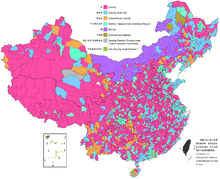Counties of the People's Republic of China
|
formally County-level divisions | |||||||||
 | |||||||||
| Chinese name | |||||||||
|---|---|---|---|---|---|---|---|---|---|
| Simplified Chinese | 县级行政区 | ||||||||
| Traditional Chinese | 縣級行政區 | ||||||||
| |||||||||
| Alternative Chinese name | |||||||||
| Simplified Chinese | 县 | ||||||||
| Traditional Chinese | 縣 | ||||||||
| |||||||||
| Tibetan name | |||||||||
| Tibetan |
རྫོང་ (formerly 宗 in Chinese) | ||||||||
| |||||||||
| Zhuang name | |||||||||
| Zhuang | Hen | ||||||||
| Mongolian name | |||||||||
| Mongolian script | ᠰᠢᠶᠠᠨ | ||||||||
| |||||||||
| Uyghur name | |||||||||
| Uyghur |
ناھىيە | ||||||||
| |||||||||
| This article is part of a series on |
| Administrative divisions of China |
|---|
|
Analogous county level units Management areas Management committee |
|
Townships
Subdistricts County-controlled districts (pilot) |
|
Analogous township level units Management areas Management committee Areas Farms area, Prison area, University towns etc. |
|
|
|
History: before 1912, 1912–49, 1949–present Administrative division codes |
Counties, formally county-level divisions, are found in the third level of the administrative hierarchy in Provinces and Autonomous regions, and the second level in municipalities and Hainan, a level that is known as "county level" and also contains autonomous counties, county-level cities, banners, autonomous banner, and City districts. There are 1,464 counties in Mainland China out of a total of 2,862 county-level divisions.
Xian have existed since the Warring States period, and were established nationwide during the Qin Dynasty. The term xian is usually translated as "districts" or "prefectures" when put in the context of Chinese history. This article, however, will try to keep the terminology consistent with the modern translation, and use the term "county" throughout, though this is not conventional practice in Sinology literature.
History
Xian have existed since the Warring States period and were set up nationwide by the Qin Dynasty. The number of counties in China proper gradually increased from dynasty to dynasty. As Qin Shi Huang reorganized the counties after his unification, there were about 1,000. Under the Eastern Han Dynasty, the number of counties increased to above 1,000. About 1400 existed when the Sui dynasty abolished the commandery level (郡 jùn), which was the level just above counties, and demoted some commanderies to counties. The current number of counties mostly resembled that of the later years of Qing Dynasty. Changes of location and names of counties in Chinese history have been a major field of research in Chinese historical geography, especially from the 1960s to the 1980s.
In Imperial China, the county was a significant administrative unit because it marked the lowest level of the imperial bureaucratic structure; in other words, it was the lowest level that the government reached. Government below the county level was often undertaken through informal non-bureaucratic means, varying between dynasties. The head of a county was the magistrate, who oversaw both the day-to-day operations of the county as well as civil and criminal cases.
Autonomous counties
Autonomous counties (自治县 Pinyin: zìzhìxiàn) are a special class of counties in Mainland China reserved for non-Han Chinese ethnic minorities. Autonomous counties are found all over China, and are given, by law, more legislative power than regular counties.
There are 117 autonomous counties in Mainland China.
Government
As the Communist Party of China is central to directing government policy in Mainland China, every level of administrative division has a local CPC Committee. A county's is called the CPC County Committee (中共县委) and the head called the Secretary (中共县委书记), the de facto highest office of the county. Policies are carried out via the People's government of the county, and its head is called the County Governor (县长). The governor is often also one of the deputy secretaries in the CPC Committee.
See also
- County
- List of counties in the People's Republic of China
- List of county-level divisions of China
- History of the administrative divisions of China